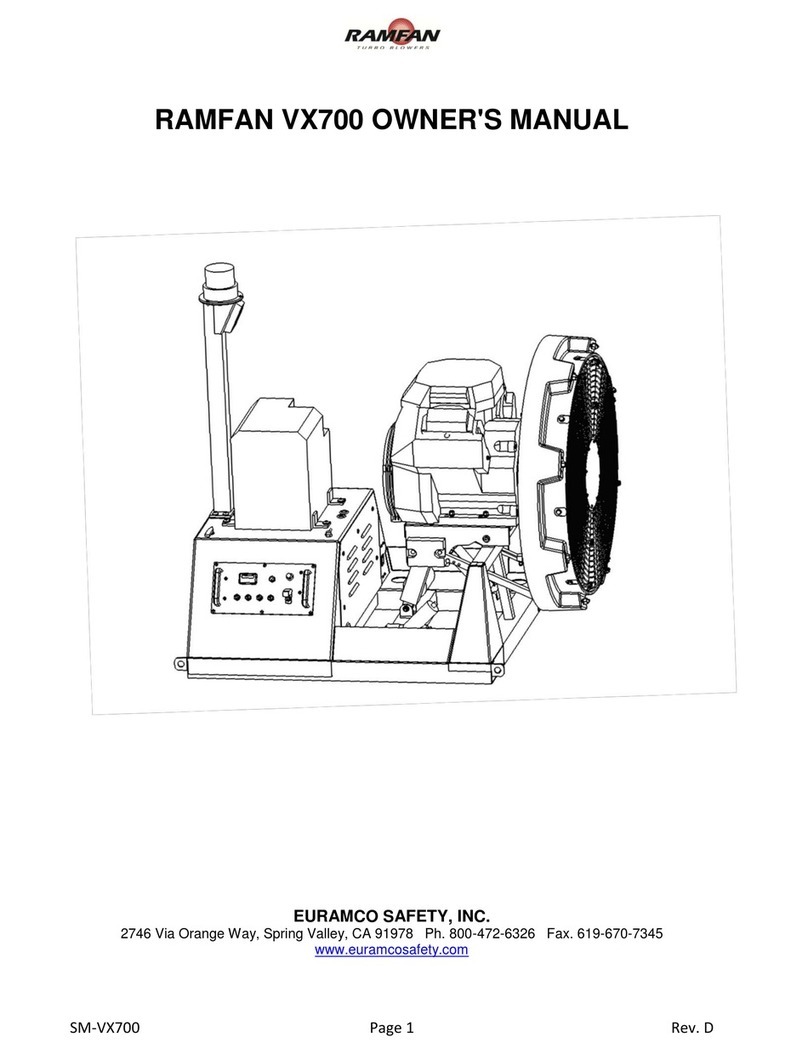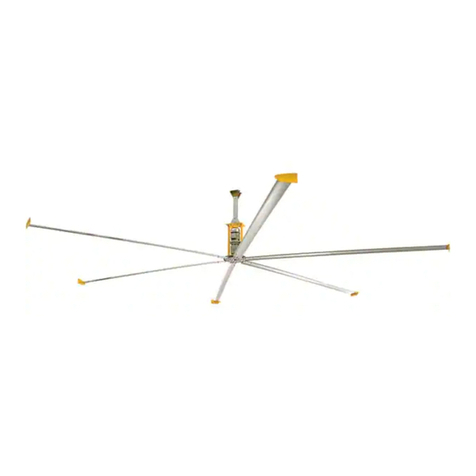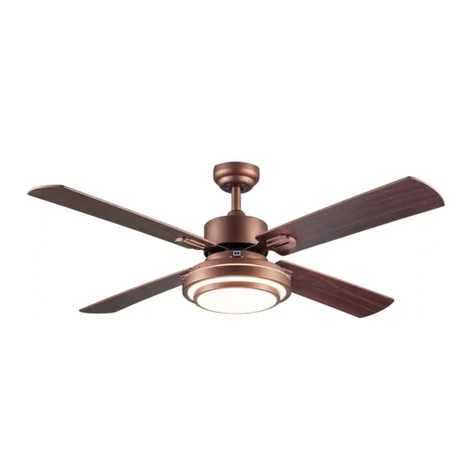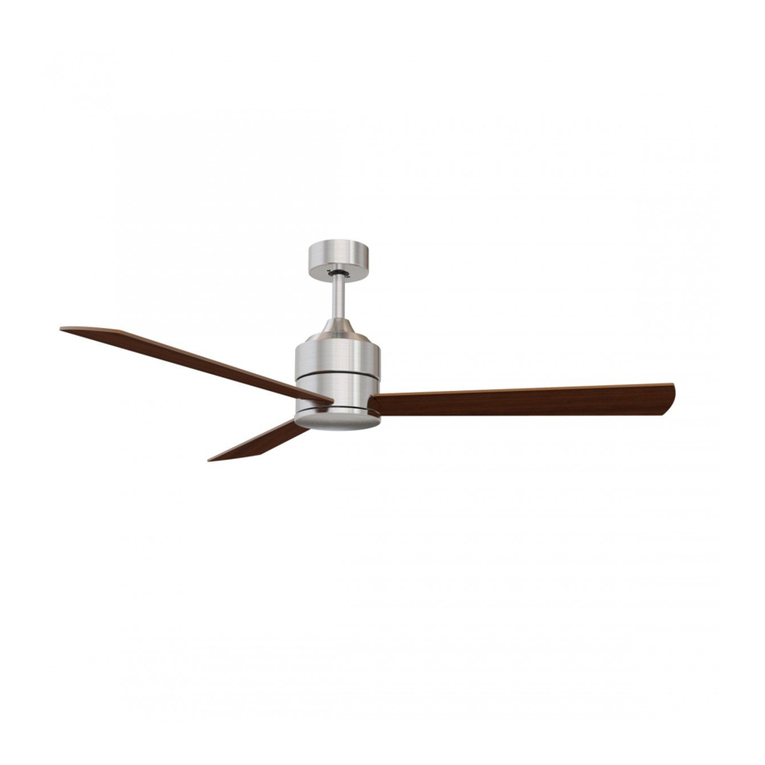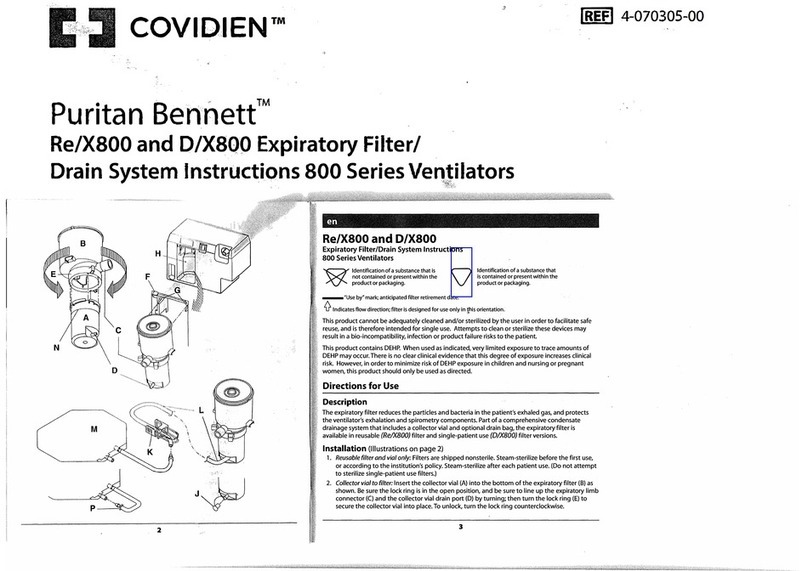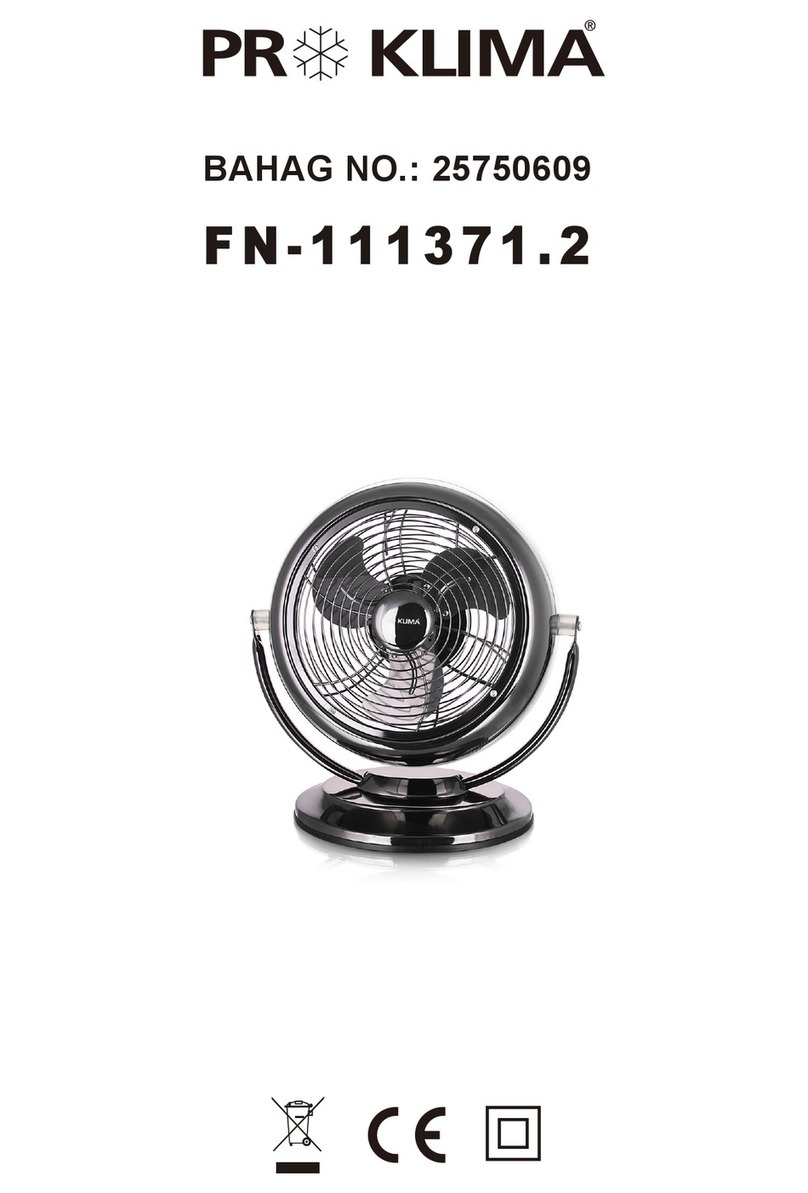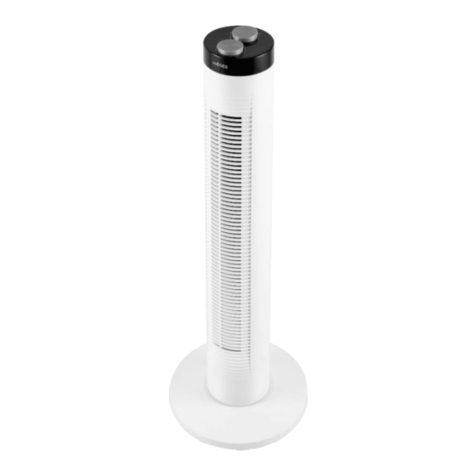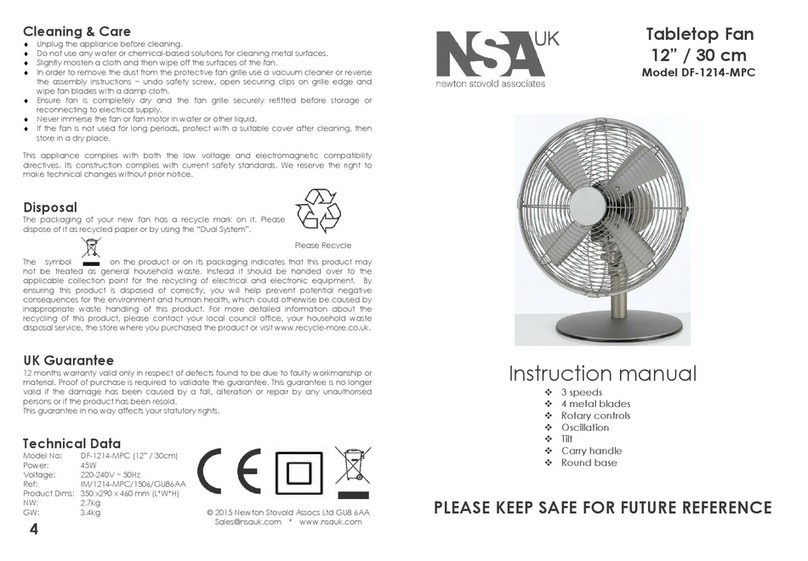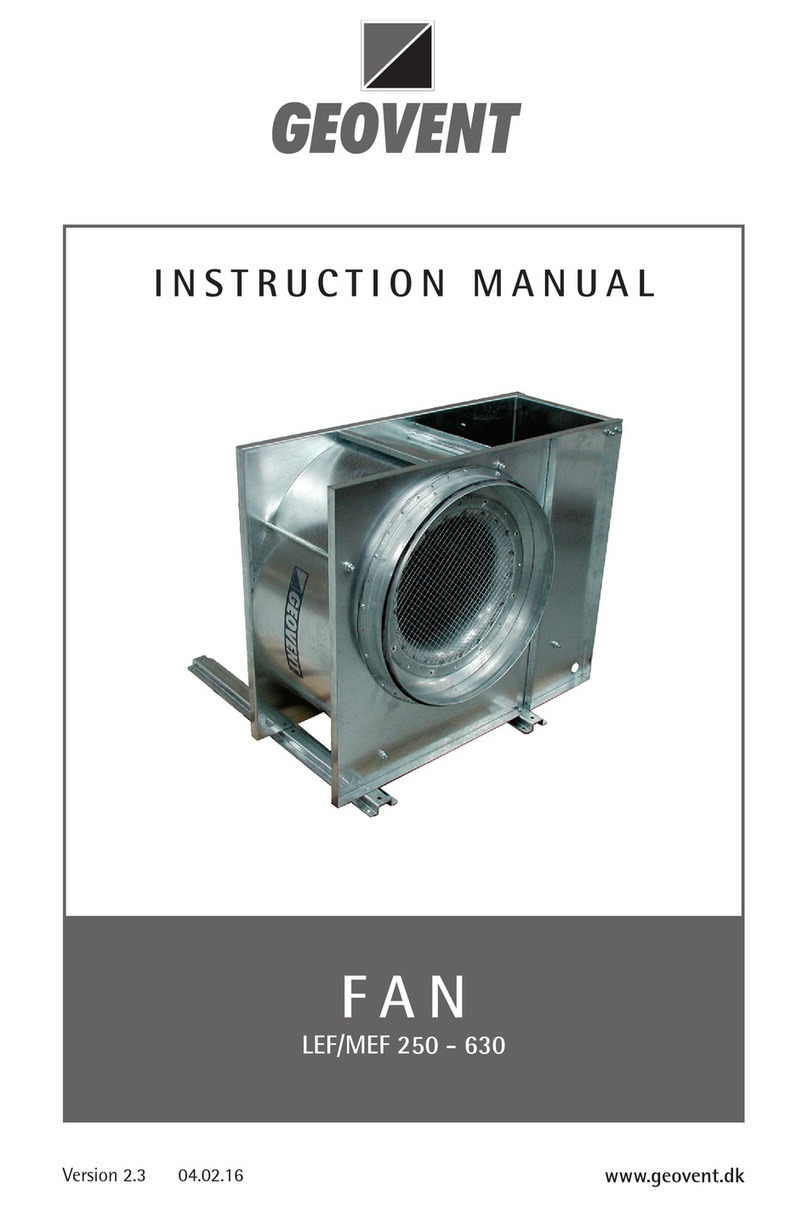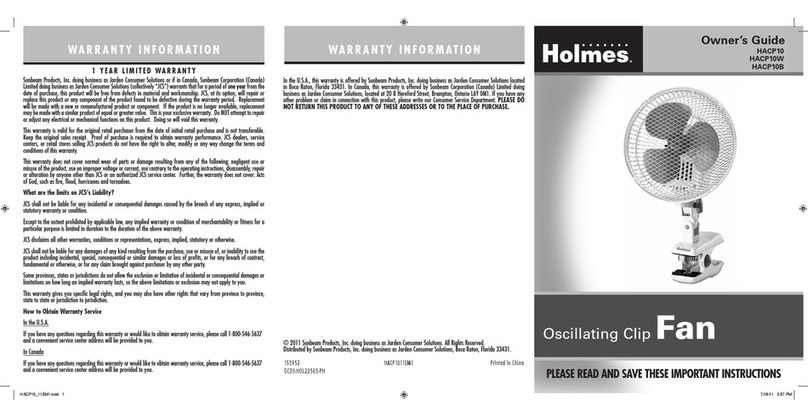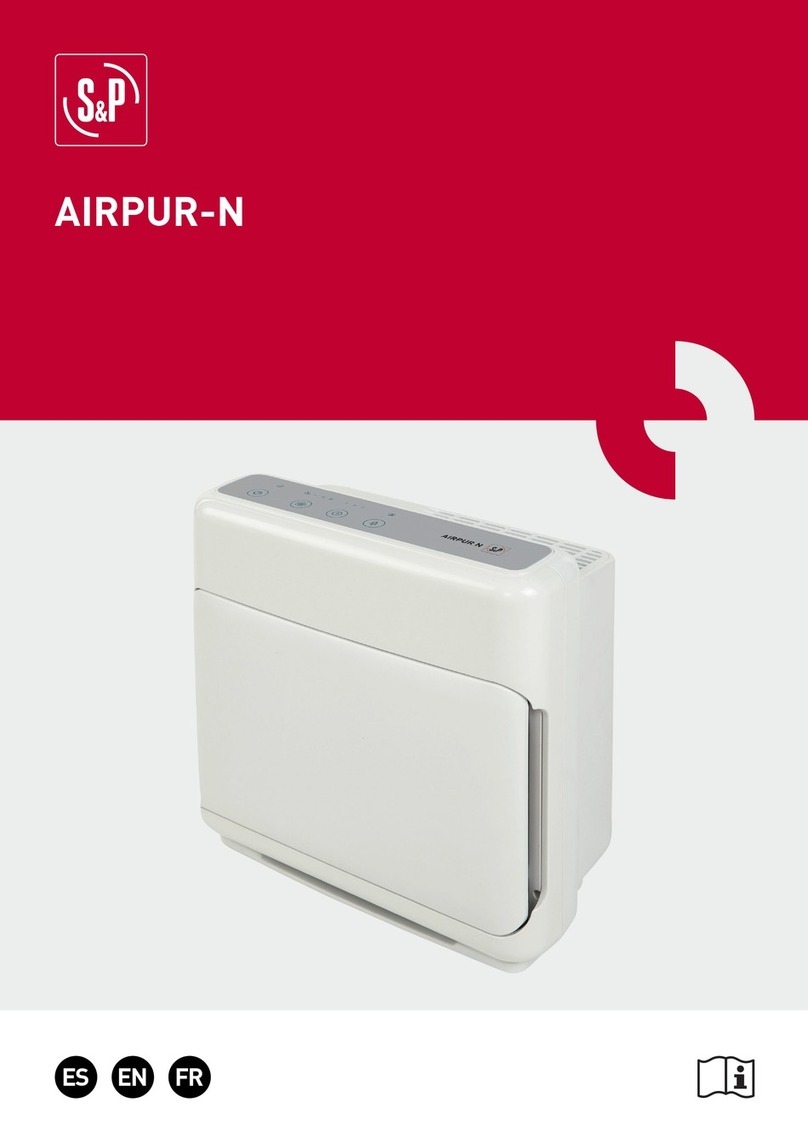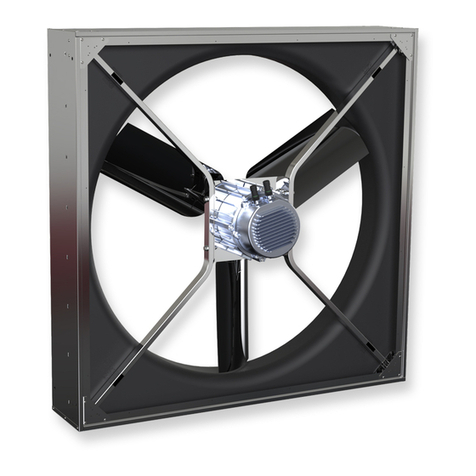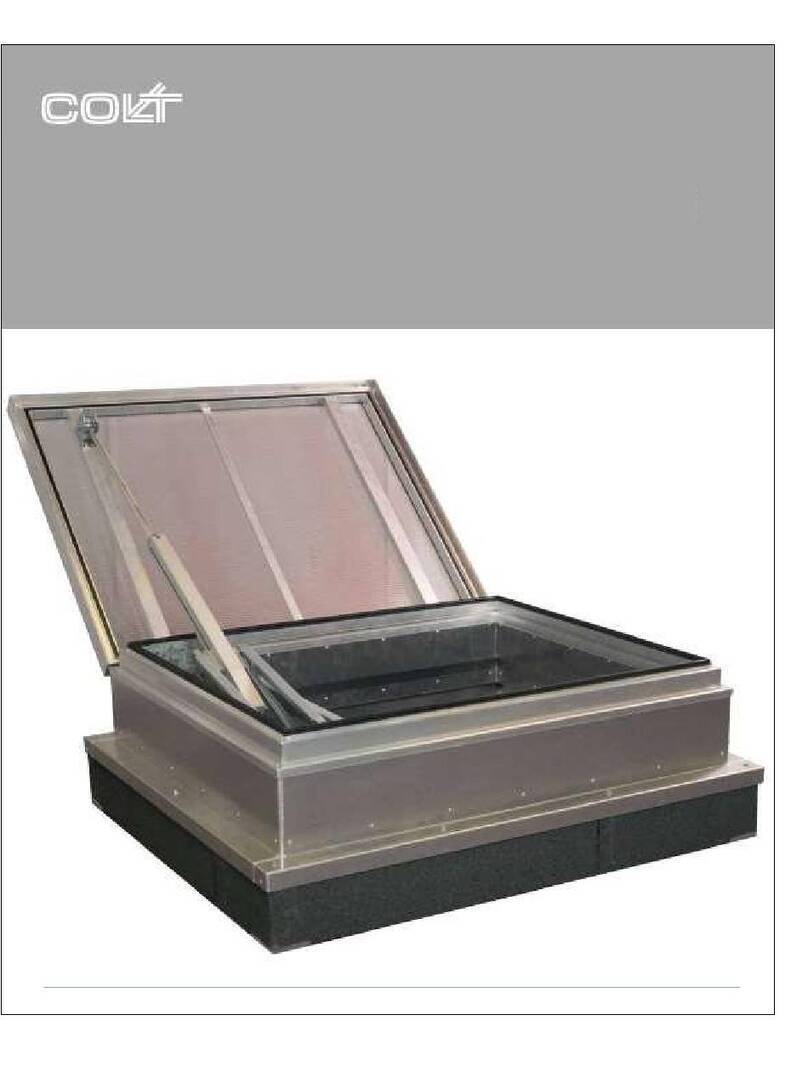Enigma Enigma FP2120xx Series User manual

OWNER’S MANUAL
READ AND SAVE THESE INSTRUCTIONS
Model No. FP2120** Series
Enigma®
Ceiling Fan
Suitable for use with Solid State Speed Controls
WARNING: Support Directly From Building Structure
Net Weight 38 lbs. or 17.3 kg.
For Canada, this fan must be secured directly to the building structure or ceiling joist.
Don’t secure this fan to an outlet box.

.
Table of Contents
Unpacking Instructions . . . . . . . . . . . . . . . . . . . . . . . . . . . . . . . . . . . . . . . . . . . . . . . . . . . . . . . . . . .3
Electrical and Structural Requirements . . . . . . . . . . . . . . . . . . . . . . . . . . . . . . . . . . . . . . . . . . . . . .4
How to Assemble Your Ceiling Fan. . . . . . . . . . . . . . . . . . . . . . . . . . . . . . . . . . . . . . . . . . . . . . . . . .4
How to Hang Your Ceiling Fan . . . . . . . . . . . . . . . . . . . . . . . . . . . . . . . . . . . . . . . . . . . . . . . . . . . . .6
How to Wire Your Ceiling Fan . . . . . . . . . . . . . . . . . . . . .. . . . . . . . . . . . . . . . . . . . . . . . . . . . . . . . .7
Operating Instructions - TR24WH Hand-held Remote . . . . . . . . . . . . . . . . . . . . . . . . . . . . . . . . . .7
Installing the Canopy Housing . . . . . . . . . . . . . . . . . . . . . . . . . . . . . . . . . . . . . . . . . . . . . . . . . . . . .8
Final Assembly - Options. . . . . . . . . . . . . . . . . . . . . . . . . . . . . . . . . . . . . . . . . . . . . . . . . . . . . . . . . .8
Maintenance . . . . . . . . . . . . . . . . . . . . . . . . . . . . . . . . . . . . . . . . . . . . . . . . . . . . . . . . . . . . . . . . . . . .9
Trouble Shooting . . . . . . . . . . . . . . . . . . . . . . . . . . . . . . . . . . . . . . . . . . . . . . . . . . . . . . . . . . . . . . . .9
Parts List . . . . . . . . . . . . . . . . . . . . . . . . . . . . . . . . . . . . . . . . . . . . . . . . . . . . . . . . . . . . . . . . . . . . . .10
Exploded-View Illustration. . . . . . . . . . . . . . . . . . . . . . . . . . . . . . . . . . . . . . . . . . . . . . . . . . . . . . . .11
1. LIMITED LIFETIME MOTOR WARRANTY - If any part of your fan motor fails, due to a defect in materials or workmanship during
the lifetime of the original purchaser, Fanimation will provide the replacement part free of charge, when the defective fan is returned
to our national service center. Proof of purchase is required. Customer shall be responsible for all costs incurred in the removal or
reinstallation and shipping of the product for repairs or replacement.
2. ONE YEAR MOTOR LABOR WARRANTY - If your fan motor fails at any time within one year from the original purchase, due to
defects in materials or workmanship, labor to repair the motor will be provided free of charge at our national service center. Purchaser
will be responsible for labor charges after this one-year period. Customer shall be responsible for all costs incurred in the removal or
reinstallation and shipping of the product for repairs or replacement.
3. If any other part of your fan fails at any time within one year after original purchase, due to a defect in materials or workmanship, we
will repair, or replace, at our option, the defective part free of charge for parts and labor performed at our national service center.
4. Because of varying climate conditions, this warranty does not cover changes in the finish, including rusting, pitting, corroding,
tarnishing, or peeling.
5. This warranty is void and does not apply to damage from improper installation, neglect, accident, misuse, exposure to extremes of
heat or humidity, or as a result of any modification to the original product.
6. All costs of removal and reinstallation of the fan are the sole responsibility of the owner of the fan and not the store that sold the fan
or Fanimation.
7. Fanimation reserves the right to modify or discontinue any product at any time and may substitute any part under this warranty.
8. Under no circumstances may a fan be returned without prior authorization from Fanimation. The receipt of purchase must ac-
company authorized returns and must be sent freight prepaid to Fanimation. The fan to be returned must be properly packed to avoid
damage in transit; Fanimation will not be responsible for any damage resulting from improper packaging.
9. It is understood that any repair or replacement is the exclusive remedy available from Fanimation. There is no other expressed or
implied warranty. Fanimation hereby disclaims any and all implied warranties, including, but not limited to those of merchantability and
fitness for a particular purpose to the extent permitted by law. Some states do not allow limitations on implied warranties. Fanimation
will not be liable for incidental, consequential, or special damages arising out of or in conjunction with product use or performance,
except as may otherwise be accorded by law. This warranty gives you special legal rights and you may also have other rights that vary
from state to state.
10. A certain amount of wobble is normal and should not be considered a problem or a defect.
1. Read your owner’s manual and safety information before installing your new fan. Review the accompanying assembly diagrams.
2. Before servicing or cleaning unit, switch power off at service panel and lock service panel disconnecting means to prevent power
from being switched on accidentally. When the service disconnecting means cannot be locked, securely fasten a warning device, such
as a tag, to the service panel.
3. Be careful of the fan and blades when cleaning, painting, or working near the fan. Always turn off the power to the ceiling fan before
servicing.
4. Do not insert anything into the fan blades while the fan is operating.
5. Do not operate reversing switch until fan blades have come to a complete stop.
LIMITED LIFETIME WARRANTY
Extends to the original purchaser of a Fanimation Fan
Additional Safety Instructions
Important Safety Instructions
WARNING: To avoid fire, shock and serious personal injury, follow these instructions.
1. To avoid possible shock, be sure electricity is turned off at the fuse box before wiring, and do not operate fan without blades.
2. All wiring and installation procedures must satisfy National Electrical Codes (ANSI/ NFPA 70-1999). Use the National Electrical Code
if Local Codes do not exist. The ceiling fan must be grounded as a precaution against possible electrical shock. Electrical installation
should be made or approved by a licensed electrician.
3. The fan base must be securely mounted and capable of reliably supporting at least 50 lbs. Outlet boxes are not acceptable for fan
support. See page 4 of owner’s manual for support requirements. Consult a qualified electrician if in doubt.
4. CAUTION: To reduce the risk of personal injury, mount the fan base to a ceiling joist or structural member using the hardware
provided with your fan.
WARNING: Support Directly from Building Structure.
5. The fan must be mounted with the fan blades at least 7 feet from the floor to prevent accidental contact with the fan blades.
6. Follow the recommended instructions for the proper method of wiring your ceiling fan. If you do not have adequate electrical
knowledge or experience, have your fan installed by licensed electrician.
7. Suitable for use with solid-state speed controls.
WARNING: To reduce the risk of fire or electric shock, this fan should only be used with Fan Speed Control Part No. UC7051R,
manufactured by Rhine Electronic Co., Ltd.
WARNING: TO REDUCE THE RISK OF SHOCK, THIS FAN MUST BE INSTALLED WITH AN ISOLATING WALL CONTROL/SWITCH.
WARNING: This product is designed to use only those parts supplied with this product and/or accessories designated specifically for
use with this product. Using parts and/or accessories not designated for use with this product could result in personal injury or property
damage.
WARNING: To reduce the risk of personal injury, do not bend the blade bracket (flange or blade holder) when installing the brackets,
balancing the blades, or cleaning the fan. Do not insert foreign objects in between rotating fan blades.

3
This Manual is Designed to Make it as Easy as Possible for You
to Assemble, Install, Operate, and Maintain Your Ceiling Fan
Unpacking Instructions
For your convenience, check-off each step. As each step is completed, place a check mark. This will ensure that all
steps have been completed and will be helpful in finding your place should you be interrupted.
Wiring outlet box and box connectors must be of type re-
quired by local code. The minimum wire would be a 3-con-
ductor (2-wire with ground) of the following size:
NOTE: Place the parts from the loose parts bags in a
small container to keep them from being lost. If any parts
are missing, contact your local retailer.
Tools Needed for Assembly Materials
•One Phillips head screwdriver
•One stepladder
•One ¼” blade screwdriver
•916” Socket head wrench
•One wire stripper
Wire Size A.W.G.Installed Wire Length
14
12
Up to 50 ft.
50 - 100 ft.
NOTE: If you are uncertain of part description, refer to
exploded view illustration. (Figure 1, page 11)
Check to see that you have received the following parts:
• Hardware bag:
– Four wire connectors
– Two 5/32” threaded rods
– Two 5/32” lockwashers
– Two 5/32” knurled knobs
• Support Cable bag:
– Ceiling Support Cable
– Cable Clamp
– ” x 2” lag bolt
– ” flat washer
• Lower Cover Assembly
• Lower Cap
• TR24WH Hand-held Remote
• Receiver Unit
Downrod/
Hanger Ball
Assembly
Hanger
Bracket
Lower Cover
Assembly
Ceiling Fan
Assembly
Hardware Bag
Ceiling Canopy
Receiver
Unit
TR24WH Hand-held
Remote
• Ceiling Fan assembly
• Downrod/Hanger Ball assembly
• Ceiling Canopy
• Hanger Bracket
• Motor Coupling Cover
Motor Coupling
Cover
▲
WARNING
Do not install or use fan if any part is damaged or
missing. This product is designed to use only those
parts supplied with this product and/or any accessories
designated specifically for use with this product by
Fanimation. Substitution of parts or accessories not
designated for use with this product by Fanimation could
result in personal injury or property damage. Contact
your retail store for missing or damaged parts.
▲
WARNING
Before assembling your ceiling fan, refer to section on
proper method of wiring your fan (page 4). If you feel you
do not have enough wiring knowledge or experience,
have your fan installed by a licensed electrician.
Lower Cap
NOTE: The illustration shown is not to scale or its actual configuration may vary.
Wires partially removed for clarity.

4
Electrical and Structural Requirements
Your new ceiling fan will require a grounded electrical
supply line of 120 volts AC, 60 Hz, 15 amp circuit. The
outlet box must be securely anchored and capable of
withstanding a load of at least 50 lbs. Figure 1 depicts
different structural configurations that may be used for
mounting the outlet box.
If your fan is to replace an existing light fixture, turn
electricity off at the main fuse box at this time and remove
the existing light fixture.
1. To prevent damage to housing and/or blade, leave
the Ceiling Fan Assembly in its original packing during
installation of lower cover assembly, down rod, ceiling
canopy and motor coupling cover.
NOTE: Do not set Ceiling Fan Assembly on floor or hard
surface.
2. Prior to assembly, set aside and save the hardware
bag(s) packed in the packing.
3. Assemble the Lower Cover Assembly by connecting
the 2-pin (black & white wires) socket connector to
the plug connector (blue & white wires). Be sure the
connector wires are inside the Control Housing before
assembling the Lower Cover Assembly. (Figure 1)
4. Locate and loosen two Indexing Screws located on the
Control Housing. (Figure 1) Line up the indexing holes
over the screws, secure by twisting the Lower Cover
Assembly clockwise and tighten the two indexing screws.
(Figure 2)
5. Turn the Ceiling Fan Assembly (in package) top-side
up for installing down rod, ceiling canopy and motor
coupling cover.
How to Assemble Your Ceiling Fan
Figure 1
Control
Housing
Index Screw (2 places)
2-pin
connector
2˝x 4˝
Ceiling
Joists
Ceiling
Outlet
Box
Figure 1
▲
WARNING
To avoid fire or shock, follow all wiring instructions
carefully. Any electrical work not described in these
instructions should be done or approved by a licensed
electrician.
▲
WARNING
Turning off wall switch is not sufficent. To avoid
possible electrical shock, be sure electricity is turned
off at the main fuse box before wiring. All wiring must
be in accordance with National and Local codes and the
ceiling fan must be properly grounded as a precaution
against possible electrical shock.
Figure 2
Indexing
Holes
(2 places)
▲
WARNING
To reduce the risk of fire, electrical shock, or personal
injury, mount fan to outlet box marked acceptable
for fan support of 22.7 kg (50 lbs) or less. Use screws
supplied with outlet box. Most outlet boxes commonly
used for support of light fixtures are not acceptable for
fan support and may need to be replaced. Consult a
qualified electrician if in doubt.

5
How to Assemble Your Ceiling Fan (cont’d)
6. Remove the Hanger Ball by loosening the setscrew
in the Hanger Ball until the ball falls freely down the
Downrod. (Figure 3a) Remove the Pin from the
Downrod, then remove the Hanger Ball. Retain the Pin
and Hanger Ball for reinstallation in Step 9.
7. Separate and untwist the three wires and the safety
cable. Route the leads through the Downrod.
8. Loosen the two setscrews in the Downrod Support.
Align the Clevis Pin holes in the Downrod with the holes
in the Downrod Support. Install the Clevis Pin and secure
with the Hairpin Clip. (Figure 3b)
9. Pass the Downrod/Hanger Ball Assembly through the
top of the ceiling canopy and push the bell-shaped motor
coupling cover on to the downrod as shown. (Figure 4)
NOTE: You will be using either the 6” downrod supplied
with your fan or an optional downrod purchased
seperately.
10. Loosen the two setscrews in the downrod support.
Align the clevis pin holes in the downrod with the holes
in the downrod support. Install the clevis pin and secure
with the hairpin clip (Figure 3). The clevis pin must go
through the holes in the downrod support and the holes
in the downrod. Be sure to push the straight leg of the
hairpin clip through the hole near the end of the clevis pin
until the curved portion of the hairpin clip snaps around
the clevis pin. The hairpin clip must be properly installed
to prevent the clevis pin from working loose. Pull on
the hanger ball to make sure the clevis pin is properly
installed.
11. While pulling up on the hanger ball, securely tighten
the two setscrews in the downrod support (Figure 3).
NOTE: The setscrews must be properly installed as
described above, or fan-wobble could result.
12. Slide the motor coupling cover down until it touches
the top of the motor.
13. The fan comes with a support cable, blue, black,
orange and white leads. Before installing fan, measure
up approximately 6-9 inches above top of Downrod/
Hanger Ball Assembly. Cut off excess cable and wire.
Strip back insulation ½” from end of each wire.
Clevis
Pin
Ceiling
Canopy
Motor
Coupling
Cover
Hanger
Ball
Assembly
Downrod
Support
Hairpin
Clip
Setscrew (2)
14. You have now completed the assembly of your new
ceiling fan. You can now proceed with the hanging and
the electrical wiring of your fan.
Figure 3b
Figure 4
▲
WARNING
It is critical that the clevis pin in the downrod support
is properly installed and the setscrews are securely
tightened. Failure to verify that the pin and setscrews
are properly installed could result in the fan falling.
Figure 3a
Setscrew Pin

Junction
Box
Ceiling
Support
Cable
Ceiling Joist
Wood Member
(2” x 4” Approx.)
Hanger Bracket
Ceiling
Downrod/Hanger
Ball Assembly
Attach
Safety Cable to
Ceiling Support
Cable
Tab
NOTE: Supply wires and
fan wires omitted for clarity
Ceiling
Floor
Ceiling
No
less than
7 ft
Blade Radius 30˝
(60˝Blade Sweep)
6
How to Hang Your Ceiling Fan
1. Securely attach the ceiling support cable to the ceiling
joist or structural member using the ⅜˝x 2˝lag bolt and
flat washer. The lag bolt will pass through the flat washer,
loop of the ceiling support cable, the outlet box and into
the supporting member (Figure 2). You will first drill a ¼˝
pilot hole into the supporting member to prevent splitting
or cracking.
2. Securely attach the hanger bracket to ceiling junction
box acceptable for ceiling support.
NOTE: Ceiling support cable cannot be secured to
junction box only, it must be directly secured to ceiling
joist or structural member using the ⅜˝x 2˝lag bolt and
flat washer. (Figure 2).
Figure 3
Figure 2
Figure 1
3. Make sure the electrical supply wires, including the
hanger bracket grounding wire and safety cable are
pulled through the downrod, between the hanger bracket
and the junction box so that electrical connections can be
made later.
4. Carefully lift the fan and seat the downrod/hanger ball
assembly on the hanger bracket that was just attached to
the ceiling joist. Be sure the groove in the ball is lined up
with tab on the hanger bracket. (Figure 3)
5. Attach the safety cable to ceiling support cable. Slide
cable clamp onto safety cable (from fan). Place the end
of cable through the loop of ceiling support cable. Pull as
much cable through loop as possible. Feed end of cable
into clamp hole and firmly tighten screw (Figure 3). Cut
off excess safety cable.
INSTALLATION NOTE
If you are installing your ceiling fan on a sloped ceiling,
the hanger bracket must be mounted with the opening
parallel to the slope.
INSTALLATION NOTE
Be sure that the safety cable (along with the electrical
supply wires) is pulled through the downrod when
installing the downrod.
▲
WARNING
Failure to seat tab in groove could cause damage to
electrical wires and possible shock or fire hazard.
▲
WARNING
To avoid possible shock, do not pinch wires between the
downrod/hanger ball assembly and the hanger bracket.
▲
WARNING
The fan must be hung with at least 7´ of clearance from
floor to blade (Figure 1)
▲
WARNING
To avoid possible electrical shock, be sure electricity is
turned off at the main fuse box before hanging.
NOTE: If you are not sure if the outlet box is grounded,
contact a licensed electrician for advice, as it must be
grounded for safe operation.

Receiver Unit
Ceiling
Bracket
(Open End)
NOTE: Receiver wires omitted for clarity.
BLK-ANT
BL-AC IN L
WH-AC IN N
BLUE-FOR LIGHT DOWN
BLK-TO MOTOR L
WH-TO MOTOR N
GRN or BARE GROUND
GRN from hanger ball
GRN from bracket
120 VAC SUPPLY
(User Supplied)
7
How to Wire Your Ceiling Fan
Operating Instructions - TR24WH Hand-held Remote
1. Setting the Code: The remote unit has 16 different
code combinations. To prevent possible interference from
or to other remote units such as garage door openers, car
alarm or security systems, simply change the combination
code in your transmitter and receiver. To set the code,
perform these steps.
•Transmitter: remove battery cover. Press firmly below
arrow and slide battery cover off. Slide code switches to
your choice of up or down position. Factory setting is all
up. Do not use this position. With a small screwdriver or
ball point pen slide firmly up or down (Figure 1a). Replace
battery cover on the transmitter.
•Receiver: Slide code switches to the same positions
as set on your transmitter (Figure 1b).
Ifyou feel thatyou do nothave enoughelectricalwiring
knowledge or experience, have your fan installed by a
licensed electrician.
2. Installing Receiver in Hanger Bracket:
• Slide remote Receiver into the Hanger Bracket
(Figure 2).
• Connect wires as indicated: (Figure 3)
– Green Hanger Bracket and Hanger Ball wires to
BARE (ground) wire.
– BLACK Receiver Unit wire (AC IN L) to BLACK
supply wire.
– WHITE Receiver Unit wire (AC IN N). to WHITE
supply wire.
– WHITE Receiver Unit wire (TO MOTOR N) to WHITE
fan wire.
– BLACK Receiver Unit wire (TO MOTOR L) to BLACK
fan wire.
– BLUE Receiver Unit wire (FOR LIGHT DOWN) to
BLUE light wire.
• Position all connected wires and receiver antenna to
allow installation of ceiling canopy.
•To install ceiling canopy, see page 8.
• Restore electrical power.
NOTE: If fan or supply wires are different colors than indicated,
have this unit installed by a quali ed electrician.
• HI Push Button – high fan speed
• MED Push Button – medium fan speed
• LOW Push Button – low fan speed
• OFF Push Button – fan off
•Light Push Button – no function (unless light bulb is
installed)
Figure 2
Figure 3
▲
WARNING
Check to see that all connections are tight, including
ground, and that no bare wire is visible at the wire
connectors, except for the ground wire. Do not operate
fan until the blades is in place. Noise and fan damage
could result.
▲
WARNING
To avoid possible electrical shock, be sure electricity is
turned off at the main fuse box before wiring.
NOTE: If you are not sure if the outlet box is grounded,
contact a licensed electrician for advice, as it must be
grounded for safe operation.
Figure 1bFigure 1a
Remote Transmitter
Unit Detail
TRANSMITTER CODES
Reciever Unit Detail
Figure 1
3V, CR2032
BATTERY
2 PCS
1. Operating & Using Hand-held Remote (Figure 1):
Install two piece of 3volt battery (If not using for long
periods of time, remove battery to prevent damage to
hand-held remote). Store the hand-held remote away from
excess heat or humidity.

8
Installing the Canopy Housing
1. Screw in two threaded rods into the Hanger Bracket
(Figure 1a).
NOTE: The threaded rods in the hanger bracket serves
as guides for easier installation.
2. Securely attach the Canopy Housing to the Hanger
Bracket using the external lockwashers and knurled
knobs supplied with your fan (Figure 1b).
Figure 1a
Final Assembly - Options
1. Carefully screw the bulb in the socket firmly (Figure 1).
2. Restore power.
Figure 1
NOTE: This step is applicable after the neccessary
wiring is completed. (see page 19)
NOTE: Supply wires and fan wires omitted for clarity
1. To install lower cap - screw in lower cap into bulb
socket until tight. (Figure 3)
2. Restore power.
Figure 2
▲
WARNING
To avoid possible fire or shock, make sure that the
electrical wires are completely inside the canopy housing
and not pinched between the housing and the ceiling.
▲
WARNING
To prevent over-heating or electrical fires, use ONLY
PAR30, short-neck halogen bulb, 75 watt max, as
specified (bulb not included).
▲
WARNING
Do NOT install lower cap while the ceiling fan is on!
Figure 1b
Light Bulb Option:
Lower Cap Option:
CAUTION
To avoid possible electrical shock, be sure electricity
is turned off at the main fuse box before installing light
bulb.

9
Maintenance
Periodic cleaning of your new ceiling fan is the only
maintenance that is needed. When cleaning, use only a
soft brush or lint free cloth to avoid scratching the finish.
Abrasive and/or non-abrasive cleaning agents are not
required and should be avoided to prevent damage to
finish.
CAUTION
Do not use water when cleaning your ceiling fan. It could
damage the motor or the finish and create the possibility
of electrical shock.
Trouble Shooting
▲
WARNING
For your own safety turn off power at fuse box or circuit breaker before trouble shooting your fan.
Trouble Probable Cause Suggested Remedy
1. FAN WILL NOT START 1. Fuse or circuit breaker blown.
2. Loose power line connections to the fan, or loose
switch wire connections in the switch housing.
3. Dead battery in remote control.
1. Check main and branch circuit fuses or circuit
breakers.
2. Check line wire connections to fan and switch wire
connections in the switch housings.
CAUTION: Make sure main power is turned off !
3. Replace with fresh battery.
2. FAN SOUNDS NOISY 1. Motor noise caused by solid state variable speed
control. 1. Some fan motors are sensitive to signals from
solid-state variable speed controls. Solid-state controls
are not recommended, choose an alternative control
method.
3. FAN WOBBLES
EXCESSIVELY 1. Setscrew in downrod support is loose.
2. Setscrew in downrod/hanger ball assembly is loose.
3. Hanger bracket and/or ceiling outlet box is not
securely fastened.
1. Tighten both setscrews securely in downrod support.
2. Tighten the setscrew in the downrod/hanger ball
assembly.
3. Tighten the hanger bracket screws to the outlet box,
and secure outlet box.

10
5 Ceiling Canopy
1 Hanger Bracket P2100
APG610BL
2Downrod/Hanger Ball Assembly Containing:
ADR1-6
2a Hanger Ball Assembly
2b Downrod
2c Clevis Pin
2d Hairpin Clip
3 Ceiling Canopy PG158
4 Motor Coupling Cover AP60030
5 Ceiling Fan Assembly AMA2120
6 Lower Cover Assembly AP2101
7 Lower Cap P2120
8
9
10
Hardware Bag Containing:
HDWFP2120
RECAN34
TR24WH
5/32” Threaded Rods (2)
5/32” External Lockwashers (2)
Knurled Knobs (2)
Wire Connectors (3)
Support Cable Bag Containing:
Ceiling Support Cable
Cable Clamp
Flat Washer
⅜” x 2” Lag Bolt
Hand-held Remote
Receiver Unit
Before discarding packaging materials, be certain all parts have been removed
Parts List
Insert FINISH CODES (Refer to fan model number located on downrod support)
Model #FP2120
How To Order Parts
When ordering repair parts, always
give the following information:
• Part Number
• Part Description
• Fan Model Number
Contact your retail store for repair parts.
Ref. # Description Part #

2a
2b
2c
2d
2
8
7
6
4
5
3
9
1
10
11
NOTE: The illustration shown is not to scale or its actual configuration may vary.
Wires partially removed for clarity.
Exploded-View
Enigma®FP2120**
Figure 1

10983 Bennett Parkway
Zionsville, IN 46077
(888) 567-2055
FAX (866) 482-5215
Visit Our Website @ www.fanimation.com
Copyright 2011 Fanimation 2011 01/

Enigma®
Ventilador de techo
Peso neto 17.3 lb (38 kg)
Modelo N.º FP2120**Serie
MANUAL DEL PROPIETARIO
LEA Y GUARDE ESTAS INSTRUCCIONES
En Canadá, este ventilador debe ser fijado directamente a la estructura del edificio o de la
viga del techo. No fije este ventilador en una caja de distribución eléctrica.
Apropiado para su uso con controles de velocidad de estado sólido
ADVERTENCIA: Soporte directamente desde la estructura del edificio.

GARANTÍA LIMITADA DE POR VIDA DEL MOTOR - Si se produjera una falla en alguna de las partes del motor de su ventilador debido1. a un defecto en los materiales o en la fabricación durante el tiempo de vida del comprador original, Fanimation proporcionará la pieza de
repuesto sin cargo una vez que el ventilador defectuoso sea devuelto a nuestro centro de servicios nacional. Se requiere comprobante de
venta. El cliente se hará responsable de todos los gastos de remoción o reinstalación y envío del producto para reparaciones o sustitución.
GARANTÍA DE MANO DE OBRA DEL MOTOR POR UN AÑO - Si el motor de su ventilador fallara antes de cumplirse un año a partir del2. momento de su compra original debido a defectos en los materiales o en la fabricación, se le efectuará la reparación del mismo sin cargo
en nuestro centro de servicios nacional. El comprador se hará responsable de los gastos de mano de obra luego del período de un año.
El cliente se hará responsable de todos los gastos de remoción o reinstalación y envío del producto para reparaciones o sustitución.
Si otra pieza del ventilador fallara dentro del período de un año a partir de la fecha de compra original debido a un defecto en los3. materiales o en la fabricación, repararemos o sustituiremos, según creamos conveniente, la pieza defectuosa sin cargo alguno en
nuestro centro de servicios nacional.
Debido a las diversas condiciones climáticas, esta garantía no cubre cambios en la terminación, incluidos oxidación, corrosión,4. falta de brillo o peladuras.
Esta garantía es nula y no se aplica a daños por instalación incorrecta, negligencia, accidentes, uso indebido, exposición al calor o5. a la humedad en exceso, o como resultado de cualquier modificación realizada al producto original.
Todos los gastos de remoción y reinstalación del ventilador son responsabilidad exclusiva del propietario, y no de la tienda que6. vendió el ventilador ni de Fanimation.
Fanimation se reserva el derecho de modificar o discontinuar un producto en cualquier momento, o sustituir cualquier pieza según7. lo establecido por esta garantía.
En ningún caso se podrá devolver un ventilador sin previa autorización por parte de Fanimation. Las devoluciones autorizadas8. deberán ir acompañadas del recibo de venta y deberán enviarse a Fanimation, previo pago del flete. El ventilador que se devuelva
deberá estar embalado en forma adecuada a fin de evitar daños durante el transporte. Fanimation no se hará responsable de los
daños que resulten del embalaje incorrecto del producto.
Se entiende que las reparaciones y las sustituciones son el único recurso disponible de Fanimation. No existe ninguna otra9. garantía expresa o implícita. Por la presente, Fanimation niega todas las garantías implícitas, que incluyen, entre otras, la
comerciabilidad y la aptitud para determinado fin hasta donde la ley lo permita. Algunos estados no permiten limitaciones sobre las
garantías implícitas. Fanimation no se hará responsable por daños accidentales, resultantes o especiales derivados del uso o el
rendimiento del producto o en conjunción con éste, excepto en los casos en los que la ley así lo disponga. Esta garantía le otorga
derechos legales especiales y es posible que también goce de otros derechos que pueden variar según el estado.
Es normal que se produzca un cierto movimiento oscilante y esto no debe considerarse un problema o defecto.10.
GARANTÍA LIMITADA DE POR VIDA
Se extiende al comprador original de un ventilador Fanimation
Instrucciones de seguridad importantes
ADVERTENCIA: Siga estas instrucciones para prevenir incendios, descargas eléctricas y lesiones personales graves.
Lea el manual del propietario y la información de seguridad antes de instalar su nuevo ventilador. Observe los diagramas de1.
ensamblaje adjuntos.
Antes de llevar a cabo el mantenimiento o la limpieza de la unidad, desconecte la electricidad en el panel de servicio y bloquee los2.
medios de desconexión del mismo para evitar que se active accidentalmente. Si no se pueden bloquear los medios de desconexión
del servicio, coloque un dispositivo de advertencia, como una etiqueta, en el panel de servicio.
Tenga cuidado con la estructura y las aspas del ventilador cuando limpie, pinte o trabaje cerca del mismo. Desconecte siempre la3.
electricidad del ventilador de techo antes de llevar a cabo el mantenimiento.
No coloque nada en las aspas del ventilador cuando éste se encuentra en funcionamiento.4.
No accione el conmutador inversor hasta que las aspas del ventilador se hayan detenido por completo.5.
Instrucciones de seguridad adicionales
Para evitar posibles descargas eléctricas, asegúrese de que la electricidad esté desconectada en la caja de fusibles antes de realizar1.
la instalación eléctrica, y no haga funcionar el ventilador sin las aspas.
Todos los procedimientos de conexión eléctrica e instalación deben cumplir con los Códigos eléctricos nacionales (ANSI/NFPA2.
70-1999) y Códigos locales. El ventilador de techo debe estar conectado a tierra a fin de prevenir posibles descargas eléctricas. La
instalación eléctrica debe ser llevada a cabo o aprobada por un electricista autorizado.
Se debe fijar bien la base del ventilador; ésta debe ser capaz de soportar sin problemas al menos 22,7 kg (50 lb). Cajas de salida no
son aceptables para el apoyo de los aficionados. Consulte la página 16 del manual del propietario para ver los requisitos de soporte.
Si tiene dudas, consulte a un electricista calificado.
3.
Las aspas del ventilador deben instalarse por lo menos a 2 m (7 pies) del suelo, a fin de evitar un contacto accidental con las mismas.5.
Siga las recomendaciones sobre el método correcto de instalación eléctrica de su ventilador de techo. Si no posee la experiencia o6.
los conocimientos eléctricos adecuados, contrate a un electricista autorizado para instalar el ventilador.
Apto para usar con controles de velocidad de estado sólido.7.
ADVERTENCIA: PARA REDUCIR EL RIESGO DE DESCARGAS ELÉCTRICAS, ESTE VENTILADOR SE DEBE INSTALAR CON UN
CONTROL/INTERRUPTOR DE PARED AISLADO.
ADVERTENCIA: Este producto está diseñado para ser usado sólo con las piezas suministradas o los accesorios indicados
específicamente para el mismo. Si utiliza piezas o accesorios que no están indicados para su uso con este producto, podría
sufrir lesiones personales o dañar el ventilador. ADVERTENCIA: Este producto está diseñado para ser usado sólo con las piezas
suministradas o los accesorios indicados específicamente para el mismo. Si utiliza piezas o accesorios que no están indicados para su
uso con este producto, podría sufrir lesiones personales o dañar el ventilador.
ADVERTENCIA: Para reducir el riesgo de lesiones personales, no doble los soportes de las aspas (borde o soporte de aspas) al instalar
los soportes, balancear las aspas o limpiar el ventilador. No coloque objetos extraños entre las aspas del ventilador en funcionamiento.
Tabla de contenidos
Instrucciones para el desempaque . . . . . . . . . . . . . . . . . . . . . . . . . . . . . . . . . . . . . . . . . . . . . . . . . . . . . . . . . . . . 15
Uso eficiente de la energía en ventiladores de techo . . . . . . . . . . . . . . . . . . . . . . . . . . . . . . . . . . . . . . . . . . . . . . .16
Cómo ensamblar el ventilador de techo . . . . . . . . . . . . . . . . . . . . . . . . . . . . . . . . . . . . . . . . . . . . . . . . . . . . . . . . .16
Cómo colgar el ventilador de techo . . . . . . . . . . . . . . . . . . . . . . . . . . . . . . . . . . . . . . . . . . . . . . . . . . . . . . . . . . . .18
Cómo realizar la instalación eléctrica del ventilador de techo . . . . . . . . . . . . . . . . . . . . . . . . . . . . . . . . . . . . . . . . 19
Cómo utilizar su mando a distancia TR28 . . . . . . . . . . . . . . . . . . . . . . . . . . . . . . . . . . . . . . . . . . . . . . . . . . . . . . . 20
Instalación de la cubierta del capuchón
Opción de montaje final
. . . . . . . . . . .. . . . . . . . . . . . . . . . . . . . . . . . . . . . . . . . . . . . . . . . . . . . . 20
. . . . . . . . . .. . . . . . . . . . . . . . . . . . . . . . . . . . . . . . . . . . . . . . . . . . . . . . . . . . . . . . . . . . 20
Solución de problemas . . . . . . . . . . . . . . . . . . . . . . . . . . . . . . . . . . . . . . . . . . . . . . . . . . . . . . . . . . . . . . . . . . . . . 21
Lista de piezas . . . . . . . . . . . . . . . . . . . . . . . . . . . . . . . . . . . . . . . . . . . . . . . . . . . . . . . . . . . . . . . . . . . . . . . . . . . 22
Ilustración del despiece . . . . . . . . . . . . . . . . . . . . . . . . . . . . . . . . . . . . . . . . . . . . . . . . . . . . . . . . . . . . . . . . . . . . 23
Mantenimiento . . . . . . . . . . . . . . . . . . . . . . . . . . . . . . . . . . . . . . . . . . . . . . . . . . . . . . . . . . . . . . . . . . . . . . . . . . . 21
ADVERTENCIA: Para reducir el riesgo de incendios o descargas eléctricas, este ventilador solo debería ser utilizado con la pieza de
control de velocidad del ventilador Nº UC7067RY fabricada por Rhine Electronic Co., Ltd.
4. PRECAUCIÓN: Para reducir el riesgo de daños personales, instale la base del ventilador en una viga o parte de la estructura utilizando
el equipo suministrado con su ventilador.
ADVERTENCIA: Soporte directo desde la estructura del edificio.

15
Verifique que haya recibido las siguientes piezas:
– Cuatro conectores de los cables
–
–
–
• Bolsa del cable de soporte:
– Cable de soporte del techo
– Abrazadera del cable
– ” x 2 ” Tirafondos
– ”Arandela
• Unidad de la cubierta inferior
• Carcasa inferior
• TR24WH De mano a distancia
• Unidad del receptor
Unidad de la cubierta inferior
Unidad del motor del ventilador
TR24WH
De mano a
distancia
• Unidad del motor del ventilador
• Unidad del barral/de la interna
• Capuchón de techo
• Unidad del soporte de suspensión
• Cubierta de unión del motor
Carcasa inferior
Dos varillas roscadas de 5/32”
Dos arandelas de 5/32”
Dos pomos moleteados de 5/32”
• Bolsa de accesorios:
NOTA: Si no está seguro de la descripción de una
pieza, consulte la ilustración del despiece.
(Figura 1, página 23)
Instrucciones para el desempaque
Para su comodidad, marque cada uno de los pasos. A medida que completa cada paso, coloque una marca de verificación.
Con esto se asegurará de completar todos los pasos y podrá saber desde dónde retomar si fuera interrumpido.
• Destornillador Phillips
• Escalera de tijera
• Destornillador de ¼˝
• Pelacables
• Tres conectores de
cables (incluidos)
Este manual está diseñado para facilitar al máximo el ensamblaje, la
instalación, el funcionamiento y el mantenimiento de su ventilador de techo.
Herramientas necesarias
para el ensamblaje
ADVERTENCIA
Antes de ensamblar el ventilador de techo, consulte la
secciónsobreelmétodocorrectodeinstalacióneléctricadel
ventilador (página 18). Si siente que no posee la experiencia
o los conocimientos eléctricos necesarios, contrate a un
electricista autorizado para instalar el ventilador.
La caja de distribución eléctrica y los conectores de la caja deben ser del tipo
requerido por el código local. El cable más pequeño debe ser un cable de tres
conductores (de dos conductores con conexión a tierra) del siguiente tamaño:
NOTA: coloque las piezas de las bolsas de piezas individuales en un
contenedor pequeño para evitar que se extravíen. Si faltan piezas, pón-
gase en contacto con su proveedor local.
Materiales
tamaño del cable según el A.W.G.
(Calibre de Alambre Estadounidense)
longitud del cable instalado
14
12
hasta 15,2 m (50 pies)
de 15,2 a 30,5 m (50 a 100 pies)
ADVERTENCIA
No instale ni utilice el ventilador si falta alguna pieza
o si hay piezas dañadas. Este producto está diseñado
para ser usado sólo con las piezas suministradas o los
accesorios indicados por Fanimation específicamente
para el mismo. La sustitución de piezas o accesorios no
designados por Fanimation para usar con este producto
podría ocasionar lesiones personales o daños en el
ventilador. Póngase en contacto con su tienda si faltan
piezas o hay piezas dañadas.
Cubierta de unión
del motor
Unidad del receptor
Bolsa de accesorios
Capuchón de techo
Unidad del soporte de
suspensión
Unidad del barral/de la
semiesfera
NOTA:

16
1. Para evitar cualquier daño a la cubierta y/o las palas,
deje la unidad del ventilador de techo en su paquete
original durante la instalación de la unidad de cubierta
inferior, la varilla interior, la tulipa del techo y la cubierta de
acoplamiento del motor.
NOTA: No coloque la unidad del ventilador de techo en el
suelo o en ninguna superficie dura.
3. Ensamble la unidad de la cubierta inferior conectando
el conector de 2 clavijas (cables negro y blanco) al conector
del enchufe (cables azul y blanco). Asegúrese de que los
cables del conector estén dentro de la carcasa de control
antes de la instalación de la unidad de la carcasa inferior.
(Figura 1)
4. Ubique y afloje dos tornillos guía que están en la
cubierta central. Alinee los orificios guía con los tornillos,
asegúrelos girando la unidad de la carcasa inferior en el
sentido de las agujas de reloj y fije los dos tornillos guía.
(Figura 2)
5. Pongo boca arriba la unidad del ventilador de techo
(en el paquete) para la instalación de la varilla interior, la tulipa
del techo y la carcasa de acoplamiento del cliente.
Cómo ensamblar el ventilador de techo
Figura 1
cubierta
central
Índice de tornillo (2 plazas)
2 pins
Figura 2
Agujeros de
Index Server
(2 plazas)
Requisitos eléctricos y estructurales
Su nuevo ventilador de techo requiere una línea de
suministro eléctrico con conexión a tierra de 120 voltios de
CA, 60 Hz, circuito de 15 amperios. La caja de distribución
eléctrica debe estar bien asegurada y debe ser capaz de
soportar una carga de, al menos, 22,7 kg (50 lb). La Figura 1
muestra diversas configuraciones estructurales que podrían
utilizarse para montar la caja de distribución eléctrica.
Techo
Vigas del
techo
5 x 10 cm
(2˝ x 4˝)
Caja de
distribución
eléctrica
Figura 1
▲ADVERTENCIA
A fin de evitar incendios o descargas eléctricas, siga con
cuidado todas las instrucciones de instalación eléctrica.
Cualquier trabajo eléctrico que no se describa en estas
instrucciones deberá ser realizado o aprobado por un
electricista autorizado.
Si el ventilador irá en lugar de una lámpara existente,
desconecte la electricidad de la caja de fusibles principal
y quite la lámpara.
▲ADVERTENCIA
Apagar el interruptor de pared no es suficiente. Para
evitar posibles descargas eléctricas, asegúrese de que
la electricidad esté desconectada de la caja de fusibles
principal antes de realizar la instalación eléctrica. Toda
instalación eléctrica debe cumplir con los Códigos
Nacionales y Locales y el ventilador de techo debe tener
la conexión a tierra adecuada como forma de precaución
ante posibles descargas eléctricas.
▲ADVERTENCIA
Para reducir el riesgo de incendios, descargas eléctricas o
lesionespersonales,fijeelventiladoralacajade distribución
eléctrica marcada como aceptable para un peso de 22,7
kg (50 lb) o menos. Utilice los tornillos suministrados con
la caja de distribución eléctrica. La mayoría de las cajas
de distribución eléctricas que comúnmente se utilizan
como soporte de lámparas no sirven como soporte de
ventiladores y es posible que deban reemplazarse. Consulte
a un electricista calificado si tiene dudas.
2. Antes de realizar el ensamblaje, separe y guarde las
bolsas de accesorios en el empaque.

17
Cómo ensamblar el ventilador de techo (cont.)
7. Separe y desenrosque los tres cables y el cable de
seguridad. Introduzca los cables a través de la varilla interior.
9. Pase la varilla interior / unidad de bola colgante a través
de la parte superior de la tulipa del techo y presione la
carcasa de acoplamiento del motor con forma de campana
sobre la varilla interior como se muestra en las ilustraciones.
(Figura 4)
Figura 3b
Figura 4
Figura 3a
6. Afloje el tornillo de fijación de la semiesfera para lograr
que ésta pueda desplazarse libremente por el barral.
(Figura 3a) Retire el pasador del barral y luego extraiga la
semiesfera. Conserve el pasador y la semiesfera para su
reinstalación en el Paso 9.
8. Afloje los dos tornillos de fijación del soporte del barral.
Alinee los orificios del pasador en el barral con los orificios
del soporte del mismo. Instale la clavija de horquilla y
asegúrela con la pinza de horquilla. (Figura 3b)
NOTA: Podrá utilizar el barral de 15,24 cm (6”) que
viene con el ventilador o un barral opcional comprado
por separado.
Es de suma importancia que el tornillo Clevis en el soporte del
barral esté colocado correctamente y que los tornillos de fijación
y las tuercas estén bien ajustados. Si el tornillo Clevis, las
tuercas, el pasador de horquilla y los tornillos de fijación no
están correctamente colocados, el ventilador podría caerse.
▲
ADVERTENCIA
10. Afloje los dos tornillos de fijación del soporte del barral.
Alinee los orificios del pasador en el barral con los orificios
del soporte del mismo. Instale la clavija de horquilla y
asegúrela con la pinza de horquilla. La clavija de la horquilla
debe ir a través de los orificios del soporte de la varilla interior
y de los orificios de la varilla interior. (Figura 3)
Asegúrese de que presiona el extremo derecho de la pinza
de horquilla a través del orificio cercano al final de la clavija
de horquilla hasta que la parte curva de la misma se cierre
sobre la clavija de horquilla. Debe instalar correctamente la
pinza de horquilla para evitar que se afloje la clavija de
horquilla. Tire de la varilla interior para asegurarse de la
clavija de horquilla esté bien instalada.
14. Ha completado el montaje de su nuevo ventilador de
techo. Ahora puede proceder con la operación de colgado
y cableado eléctrico de su ventilador.
12. Deslice la cubierta del motor de acoplamiento abajo
hasta que toque la parte superior de la carcasa.
13. El ventilador viene con cables azul, negros, naranja
y blanco. Antes de instalar el ventilador, mida
aproximadamente hasta 6-9 pulgadas por encima de la
unidad de la bola colgante/varilla interior. Corte el cable
restante y quite media pulgada de protección en el
extremo del cable.
11. Mientras sostiene arriba la bola colgante, fije
correctamente los dos tornillos en el soporte de
la varilla interior.(Figura 3)
NOTA: Debe colocar adecuadamente los tornillos de
presión tal y como se describe anteriormente, ya que de lo
contrario podría provocar que se tambalee el ventilador.
Cubierta de
unión
del motor
Capuchón de techo
Pasador
Bola para
colgar
Tornillo
de fijación pasador
de horquilla
Pasador
de horquilla
Unidad del
barral/de la
semiesfera
Tornillo
de fijación (2)

Blade Radio 30˝
(60˝Barrer la hoja)
18
1. Fije adecuadamente el cable de soporte del techo en
la viga de la estructura o del techo utilizando tirafondos de
⅜˝ x 2˝ y tuercas planas. El tirafondo pasará a por la tuerca
plana, la lazada del cable de soporte del techo, la caja de
electricidad y la viga de soporte (Figura 2). Puede taladrar
un primer orificio de ¼˝en la viga de soporte para evitar
que se raje o rompa nada.
Figura 1
5. Attach the safety cable to ceiling support cable. Slide
cable clamp onto safety cable (from fan). Place the end
of cable through the loop of ceiling support cable. Pull as
much cable through loop as possible. Feed end of cable
into clamp hole and firmly tighten screw (Figure 3). Cut
off excess safety cable.
NOTA LA INSTALACIÓN
NOTA LA INSTALACIÓN
Si está instalando su ventilador de techo en un techo
inclinado, el soporte colgante deberá ser ensamblado en
el paralelo abierto a la inclinación.
Asegúrese de que el cable de seguridad (junto con los
cables del suministro eléctrico) salga a través de la
varilla interior cuando la instale.
Cómo colgar el ventilador de techo
Para evitar una posible descarga eléctrica, asegúrese de
cortar la alimentación eléctrica de la caja de fusibles
principal antes de colgar el ventilador.
NOTA: Si no está seguro de si la caja de salida tiene
conexión a tierra, pida consejo a un electricista
certificado, ya que debe tener conexión a tierra para un f
uncionamiento seguro.
Debe colgar el ventilador a una distancia mínima de 2,13
m desde las aspas hasta el piso. (Figura. 1)
ADVERTENCIA
ADVERTENCIA
2. Fije adecuadamente el soporte colgante a la caja de
empalme del techo que sea aceptable para el soporte
del techo.
NOTA: el cable de soporte para techo no se puede
asegurar solamente a la caja de conexiones; se debe
asegurar directamente a la viga de techo o miembro
estructural con el tornillo de cabeza cuadrada de ⅜˝x2˝ y
la arandela plana. (Figura 2)
3. Asegúrese de que los cables de suministro eléctrico,
incluido el cable de conexión a tierra del soporte de
suspensión y el cable de seguridad, hayan atravesado el
barral, entre el soporte de suspensión y la caja de
conexiones, de modo que más tarde se pueda realizar la
instalación eléctrica.
4. Levante cuidadosamente el ventilador y coloque el
ensamble de la bola para colgar/varilla en la abrazadera
para colgar que acaba de fijar a la caja de salida.
Asegúrese de que la ranura de la bola esté alineada con
la lengüeta de la abrazadera para colgar. (Figura. 3)
ADVERTENCIA
Para evitar una posible descarga eléctrica, no apriete
los cables entre el ensamble de la bola para colgar
y la abrazadera para colgar.
ADVERTENCIA
Si no coloca la lengüeta en la ranura, podrían
dañarse los cables eléctricos y podrían ocurrir
incendios o descargas eléctricas.
EI Piso
No
menos de
2,13 m
Figura 2
Figura 3
Caja de
conexiones
Cable de
soporte
para techo
Soporte de
suspensión
Techo
Viga del techo
Miembro de
madera (5 x 10 cm
[2”x 4”] aprox.)
Unidad del barral/
de la semiesfera
Fije el cable
de seguridad
al cable de
soporte para
techo
Pestaña
NOTA: se omiten los cables
de suministro y los cables del
ventilador para mayor claridad.
EI Techo

19
licensed electrician.
Figura 3
AZUL-PARA LUZ INFERIOR
Cómo realizar la instalación eléctrica del ventilador de techo
NOTA: Si el ventilador o los cables suministrados son
diferentes de diferentes colores a los especificados, le
recomendamos que un electricista especializado realice la
instalación de esta unidad
Si siente que no posee la experiencia o los
conocimientos eléctricos necesarios, contrate a un
autorizado para instalar el ventilador.
1. Configuración del código: La unidad del mando a
distancia posee 16 combinaciones de código diferentes.
Para evitar posibles interferencias desde o hacia otras
unidades remotas, como abridores de puertas de garajes,
alarmas de coche o sistemas de seguridad, modifique
simplemente el código de combinación en su transmisor
y receptor. Para configurar el código, siga estos pasos.
Transmisor: Extraiga la cubierta de la pila. Presiona
con firmeza hacia abajo para deslizar la carcasa de la
pila. Deslice los interruptores de código según su
elección en la posición arriba o abajo. La configuración
de fábrica mantiene todos hacia arriba. Con un pequeño
destornillador o un bolígrafo de punta redonda puede
deslizar los interruptores hacia abajo o arriba (Figura 1a).
Vuelva a colocar la cubierta en el transmisor.
Receptor: Deslice los interruptores de código en las
mismas posiciones en las que configuró su transmisor
(Figura 1b).
2. Instalación del receptor en el soporte colgante:
• Deslice la unidad del receptor en el soporte colgante
(Fig 2).
• Conecte los cables tal y como se le indica:n(Figura 3)
- El soporte del gancho verde y los cable de la bola del
soporte van al cable (tierra) DESNUDO.
Figura 1bFigura 1a
Detalle del transmisor
remoto Detalle de la unidad
del receptor
Batería
de 3V
Figura 2
Receptor de
la Unidad
Techo
Soporte
(extremo abierto)
NOTA: Los cables del receptor
omitido por Clarit.
GRN desde la bola colgante
GRN desde el soporte
NEGRO A MOTOR L
BLANCO A MOTOR N
CABLE DE CONEXIÓN A
TIERRA DESNUDO o VERDE
NEGRO-ANT
NEGRO-CA EN L
BLANCO-CA EN N
SUMINISTRO
DE 120 V de CA
(suministrado por
el usuario)
•Para instalar la cubierta del techo, consulte la página 20.
•Restaure la electricidad.
3. Cuando haya conectado los cables, colóquelos de
forma extendida y empújelo hacia arriba para colocarlos
dentro de la caja de distribución eléctrica. Coloque el
conductor con toma de tierra y el conductor del equipo con
toma de tierra a un lado de la caja de distribución, colocando
el conductor sin toma de corriente al otro lado de la misma.
- Cable NEGRO de la unidad del receptor (CA EN L)
al cable de suministro NEGRO.
- Cable BLANCO de la unidad del receptor (CA EN N)
al cable de suministro BLANCO.
- Cable BLANCO de la unidad del receptor (AL
MOTOR N) al cable BLANCO del ventilador.
- Cable NEGRO de la unidad del receptor (AL
MOTOR L) al cable NEGRO del ventilador ZULARAP- Cable AZUL de la unidad del receptor (
al cable AZUL de iluminación.
• Coloque todos los cables conectados y la antena del
receptor para permitir la instalación de la unidad del
motor.
INFERIOR)
▲ADVERTENCIA
Para evitar posibles descargas eléctricas, asegúrese
de que la electricidad esté desconectada de la caja de
fusibles principal antes de realizar la instalación. NOTA:
si no está seguro si la caja de distribución eléctrica tiene
conexión a tierra, pida asesoramiento a un electricista
autorizado, ya que la conexión a tierra es importante
para un funcionamiento seguro.

20
Instalación de la cubierta del capuchón
Montaje Final - Opciones
Figura 1a Figura 1b
Instrucciones de funcionamiento - Mando a distancia de TR24WH
Compruebe que todas las conexiones realizadas
correctamente, incluyendo la toma de tierra, y que no
se visualizan ningún cable pelado en los conectores
de cables, con la excepción del cable de toma de
tierra. No utilice el ventilador hasta que las palas estén
colocadas en su lugar, ya que de lo contrario se podría
causar ruido y daños.
ADVERTENCIA
Para que funcione el ventilador, instale dos pilas de
3 voltios en el transmisor del mando a distancia.
(si no se va a utilizar por largos períodos de tiempo,
1. Funcionamiento y Utilización del Transmisor a Distancia
(Figura 1):
Figura 1
3V, CR2032
batería de
dos piezas
retire la batería para evitar daños al control remoto de
mano.) Guarde el transmisor lejos del exceso de calor o
humedad.
luz infinito
Figura 1
NOTA: Este paso se debe realizar luego de completar la
instalación eléctrica necesaria. (ver página 19)
1. Atornille dos varillas roscadas en el soporte colgante.
(Figura 1a)
2. Fije adecuadamente la carcasa de la cubierta al soporte
colgante utilizando las arandelas de seguridad y los pomos
moleteados suministrados con su ventilador.
(Figura 1b)
▲
ADVERTENCIA
Para evitar posibles incendios o corto circuitos,
asegúrese de que todos los cables eléctricos están
completamente dentro de la carcasa de la cubierta y no
están pisados entre la carcasa y el techo.
NOTA: Se omiten los cables del
suministro eléctrico y del ventilador por claridad.
1. Fije cuidadosamente la bombilla en la conexión.
(Figura 1)
2. Restaure la electricidad.
Para prevenir sobrecalentamientos o incendios, utilice la
bombilla halógena de cuello corto ONLY PAR30, de 75
vatios máx., tal y como se especifica.
(Bombilla no incluida).
Opción de bombilla:
PRECAUCIÓN
Para evitar posibles cortocircuitos, asegúrese de que la
electricidad esté apagada en el fusil central antes de
instalar la bombilla.
▲
ADVERTENCIA
This manual suits for next models
1
Table of contents
Languages:
